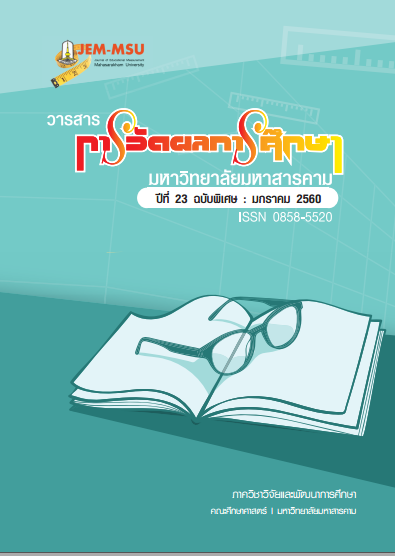The development and validation of Discipline-oriented Measurement Model for Matthayomsuksa 3 Using Affinity Diagram techniques and multitrait - multimethod analysis.
Main Article Content
Abstract
The objectives of the research were to development and checking of validity
of the model of factors influencing discipline of Matthayomsuksa 3 using affinity diagram
techniques, and validate the convergent validity and discriminant validity by multitrait -
multimethod analysis ( 4 traits 2 method ). The sample were 580 students under the
Primary Education Service Area Office of Kalasin , obtained using the multi-stage random
sampling technique. Two instruments used in the study were : Scale 1 was a measure of
discipline-oriented situations test with discriminating powers (t-test ) ranging 3.024 - 9.798
and a reliability of 0.904 ; Scale 2 was a measure of discipline rating scale test with
discriminating powers (rxy) ranging 0.259 - 0.908 and a reliability of 0.946. Data analysis based
on descriptive statistic, the Index of consistency, the Pearson’s Product moment correlation,
the Cronbach’s alpha coefficients . Confirmatory factor analysis and multitrait -multimethod
analysis was carried out using Mplus version 6.11.
The results of research showed that: 1) The model of discipline of Matthayomsuksa 3
students were in harmonious congruence with the empirical data using statistics to measure
levels of harmony with 2 =120.707 , df = 19 , p = 0.000 , 2/df = 6.353 , CFI = 0.961 , TLI
=0.942 , RMSEA = 0.096 , SRMR = 0.036. 2) The multitrait -multimethod analysis of model fit
with empirical too 2= 2.092 , df = 5, p =0.8362 ,CFI =1.000 ,TLI= 1.006 , RMSEA =0.000,
SRMR = 0.010 and 2/df = 0.4184. The statistical analysis indicated that, a measure of
discipline-oriented situations test were the Reliability, the discriminant validity and
convergent validity.
Article Details
The content and information contained in the published article in the Journal of Educational Measurement Mahasarakham University represent the opinions and responsibilities of the authors directly. The editorial board of the journal is not necessarily in agreement with or responsible for any of the content.
The articles, data, content, images, etc. that have been published in the Journal of Educational Measurement Mahasarakham University are copyrighted by the journal. If any individual or organization wishes to reproduce or perform any actions involving the entirety or any part of the content, they must obtain written permission from the Journal of Educational Measurement Mahasarakham University.


